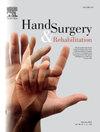Ultrasound-guided release of carpal tunnel syndrome — Anterograde technique
IF 1
4区 医学
Q4 ORTHOPEDICS
引用次数: 0
Abstract
Compression of the median nerve in the carpal tunnel is a frequent pathology with severe functional impact. An ultrasound-guided technique was developed to preserve structures, diminish scar fibrosis and enable fast return to full activity. Its advantages are safety and low additional cost.
Ultrasound-guided carpal tunnel release is indicated in moderate and severe carpal tunnel syndrome persisting after conservative treatment. A preoperative ultrasound scan is recommended to evaluate anatomy. Recurrent carpal tunnel syndrome, secondary carpal tunnel syndrome and anatomic variants compromising the safety of transverse carpal ligament division are contraindications.
The procedure is performed under local anesthesia without tourniquet. The entry point is a short transverse incision proximal to the wrist crease. The transverse carpal ligament is divided anterogradely, using a dedicated blade under ultrasound control, making sure no nerves, tendons or blood vessels are injured. The final step is to check that the division is complete. Early return to use of the hand is permitted.
Reports of similar techniques demonstrated early symptomatic relieve, favorable patient-reported outcome measures from within 1 week after surgery to 2 years’ follow-up, with early return to normal daily activity and work. The complications rate is low: many series showed no complications. Comparative studies between ultrasound-guided carpal tunnel release and the mini-open technique reported similar or greater and quicker symptom relief, less scar pain and better strength. Final functional results tend to be similar.
超声引导下腕管综合征解除术-顺行技术。
压迫腕管正中神经是一种常见的病理,具有严重的功能影响。我们开发了一种超声引导技术来保存结构,减少疤痕纤维化,并使其能够快速恢复全部活动。其优点是安全、附加成本低。超声引导下的腕管释放适用于保守治疗后持续存在的中重度腕管综合征。术前超声扫描建议评估解剖。复发性腕管综合征,继发性腕管综合征和危及腕横韧带分离安全性的解剖变异是禁忌症。手术在局部麻醉下进行,不带止血带。切入点是一个短的横向切口,靠近手腕皱褶。在超声控制下,使用专用刀片顺行分离腕横韧带,确保没有神经、肌腱或血管受伤。最后一步是检查除法是否完成。允许提前恢复使用手。类似技术的报告显示早期症状缓解,从术后1周到随访2年,患者报告的结果良好,早期恢复正常的日常活动和工作。并发症发生率低,许多系列无并发症。超声引导下的腕管松解术与小切口松解术的比较研究报告了相似或更大、更快的症状缓解,更少的疤痕疼痛和更好的强度。最终的功能结果往往是相似的。
本文章由计算机程序翻译,如有差异,请以英文原文为准。
求助全文
约1分钟内获得全文
求助全文
来源期刊

Hand Surgery & Rehabilitation
Medicine-Surgery
CiteScore
1.70
自引率
27.30%
发文量
0
审稿时长
49 days
期刊介绍:
As the official publication of the French, Belgian and Swiss Societies for Surgery of the Hand, as well as of the French Society of Rehabilitation of the Hand & Upper Limb, ''Hand Surgery and Rehabilitation'' - formerly named "Chirurgie de la Main" - publishes original articles, literature reviews, technical notes, and clinical cases. It is indexed in the main international databases (including Medline). Initially a platform for French-speaking hand surgeons, the journal will now publish its articles in English to disseminate its author''s scientific findings more widely. The journal also includes a biannual supplement in French, the monograph of the French Society for Surgery of the Hand, where comprehensive reviews in the fields of hand, peripheral nerve and upper limb surgery are presented.
Organe officiel de la Société française de chirurgie de la main, de la Société française de Rééducation de la main (SFRM-GEMMSOR), de la Société suisse de chirurgie de la main et du Belgian Hand Group, indexée dans les grandes bases de données internationales (Medline, Embase, Pascal, Scopus), Hand Surgery and Rehabilitation - anciennement titrée Chirurgie de la main - publie des articles originaux, des revues de la littérature, des notes techniques, des cas clinique. Initialement plateforme d''expression francophone de la spécialité, la revue s''oriente désormais vers l''anglais pour devenir une référence scientifique et de formation de la spécialité en France et en Europe. Avec 6 publications en anglais par an, la revue comprend également un supplément biannuel, la monographie du GEM, où sont présentées en français, des mises au point complètes dans les domaines de la chirurgie de la main, des nerfs périphériques et du membre supérieur.
 求助内容:
求助内容: 应助结果提醒方式:
应助结果提醒方式:


